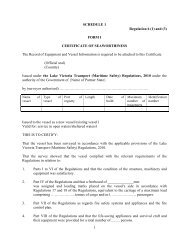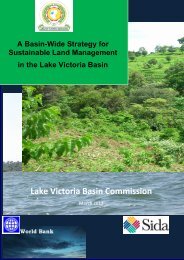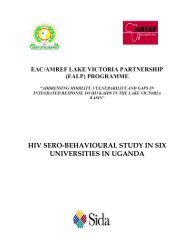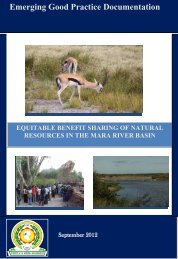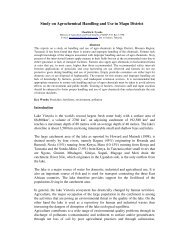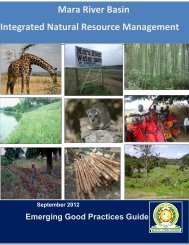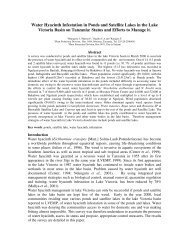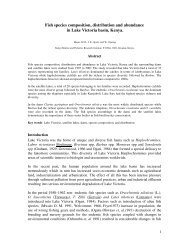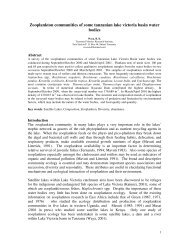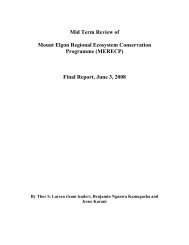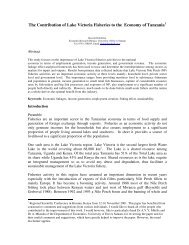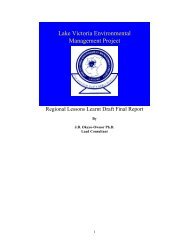Total Economic Value of Maasai Mau, Trans Mara and Eastern Mau ...
Total Economic Value of Maasai Mau, Trans Mara and Eastern Mau ...
Total Economic Value of Maasai Mau, Trans Mara and Eastern Mau ...
You also want an ePaper? Increase the reach of your titles
YUMPU automatically turns print PDFs into web optimized ePapers that Google loves.
8.0 ConclusionThis study estimated the total economic value <strong>of</strong> three forest blocks <strong>of</strong> the <strong>Mau</strong> ForestComplex. The total annual economic value <strong>of</strong> the three blocks is estimated at KES 17billion (US$ 238 million) spread throughout the economy with the direct use valuesaccounting for 12.4% <strong>of</strong> the value <strong>of</strong> the forest.The opportunity cost <strong>of</strong> changing forest into other l<strong>and</strong> uses will lead to economic lossto the economy. Incentives must therefore be given to the community <strong>and</strong> capacitybuilding provided at all fronts <strong>and</strong> levels <strong>of</strong> forest conservation, especially for thecommunity to recognize the true economic value <strong>of</strong> forest conservation.The losses that would be experienced by changing the forests to commercial agricultureor to other vegetation forms could be up to two times, demonstrating that the values <strong>of</strong>the benefits <strong>of</strong> the forest are immense.Private benefits to households are significantly smaller than those which accrue to thewider society. There is need to influence the community to appreciate the benefits <strong>of</strong> theforests in order to encourage sustainable use <strong>of</strong> forest resources.The policies <strong>and</strong> legal instruments, though sectoral in nature, were found to beadequate for encouraging conservation <strong>and</strong> development <strong>of</strong> ecosystems forenvironmental services, especially the comprehensive Environmental <strong>and</strong> CoordinationAct (EMCA, 1999). The weakness <strong>of</strong> these instruments is their segregation into sectoralset ups that fail to deal with the holistic nature <strong>of</strong> ecosystem services. An integratedapproach to the management <strong>of</strong> the Mar River Basin forest blocks may need to beforged from the many institutions that are currently interested in the <strong>Mau</strong> ForestComplex.Responsibility for conserving the forest blocks should be commensurate with thepotential or actual benefits derived. Thus, the Government <strong>of</strong> Kenya should take thelead in investing in this activity <strong>and</strong> facilitating the transfer <strong>of</strong> part <strong>of</strong> the social benefitsthat accrue downstream to those that incur costs in undertaking conservations practicesalong the MRB. There are various incentives schemes that can be can be used to supportconservation measures. The three forest blocks can be used as a model project to testsuch schemes with the support <strong>of</strong> various instruments such as REDD+ among otherspecific international conventions given the national <strong>and</strong> regional significance <strong>of</strong> <strong>Mau</strong>Forest Complex. Benefit transfer, however, raises fundamental issues <strong>of</strong> ownership71



